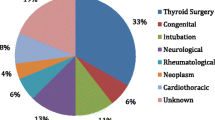Abstract
The objective of the study was to determine the etiology and subsequent management of patients with unilateral vocal fold immobility (UVFI) and compare our results with other such studies. This was a retrospective case series of all patients that were treated for UVFI at one single tertiary referral centre between 2010 and 2014. The medical records of 161 patients over a 5-year period diagnosed with UVFI were analyzed. We looked at the patient demographics, side of immobility, etiology, management and voice assessment. A total of 21 patients were excluded due to varying reasons including second presentation and incomplete data. Our results demonstrated 37.1% of cases to be due to non-thyroid surgery (mainly vascular or anterior cervical spine surgery) compared to thyroid or parathyroid (18.6%). Carotid endarterectomy was the commonest cause followed by cervical spine discectomy or fusion. Other iatrogenic causes included thoracic surgery either involving the lung or not. Our results are very much in keeping with those seen by our colleagues in North America. A better appreciation of the causes of UVFI especially in cases not performed by otolaryngologists and head and neck surgeons should be highlighted and the necessary steps should be taken to prevent this iatrogenic complication.


Similar content being viewed by others

References
Titche L (1976) Causes of recurrent laryngeal nerve paralysis. Arch Otolaryngol 102:249–261
Parnell FW, Brandenburg JH (1970) Vocal cord paralysis: a review of 100 cases. Laryngoscope 80:1036–1045
Maisel RH, Ogura JH (1974) Evaluation and treatment of vocal fold paralysis. Laryngoscope 84:302–316
Terris D, Arnstein D, Nguyen H (1992) Contemporary evaluation of unilateral vocal fold paralysis. Otolaryngol Head Neck Surg 107:84–90
Altman G, Benninger MS (1997) The evaluation of unilateral vocal fold immobility. Is chest X-ray enough? J Voice 11:364–367
Brunings W (1911) Uber eine neue Behandlungsmethode der Rekurrenslahmung. Verhandl ver dtsch Laryngol 18:93–151
Isshiki N, Morita H, Okamura H, Hiramoto M (1974) Thyroplasty as a new phonosurgical technique. Acta Otolaryngol 78:358–368
Paniello RC (2004) Laryngeal reinnervation. Otolaryngol Clin North Am 37:161–181
Swibel Rosenthal LH, Benninger MS, Deeb RH (2007) Vocal fold immobility: a longitudinal analysis of etiology over 20 years. Laryngoscope 117(10):1864–1870
Dejonckere P, Bradley P, Clemente P et al (2001) A basic protocol for functional assessment of voice pathology, especially for investigating the efficacy of phonosurgical treatments and evaluating new assessment techniques. Eur Arch Otorhinolaryngol 258:77–82
Benninger MS, Gillen JB, Altman JS (1998) Changing etiology of vocal fold immobility. Laryngoscope 108:1346–1350
Merati AL, Shemirani N, Smith TL, Toohill RJ (2006) Changing trends in the nature of vocal fold impairment. Am J Otolaryngol 27:106–108
Feehery JM, Pribitkin EA, Heffelfinger RN et al (2003) The evolving etiology of bilateral vocal fold immobility. J Voice 17:76–81
Randolph GW, Dralle H, International Intraoperative Monitoring Study Group (2011) Electrophysiologic recurrent laryngeal nerve monitoring during thyroid and parathyroid surgery: international standards guideline statement. Laryngoscope 121(Suppl 1):S1–16
Smith LJ, Rosen CA, Munin MC (2016) Vocal fold motion outcome based on excellent prognosis with laryngeal electromyography. Laryngoscope 126:2310–2314
Author information
Authors and Affiliations
Corresponding author
Ethics declarations
Funding
This study was not funded in any way or form.
Conflict of interest
The authors declares that they have no conflict of interest.
Ethical approval
This article does not contain any studies with animals performed by any of the authors.
Informed consent
Informed consent was obtained from all individual participants included in the study.
Rights and permissions
About this article
Cite this article
Prasad, V.M.N., Fakhoury, R., Helou, D. et al. Unilateral vocal fold immobility: a tertiary hospital’s experience over 5 years. Eur Arch Otorhinolaryngol 274, 2855–2859 (2017). https://doi.org/10.1007/s00405-017-4528-5
Received:
Accepted:
Published:
Issue Date:
DOI: https://doi.org/10.1007/s00405-017-4528-5



